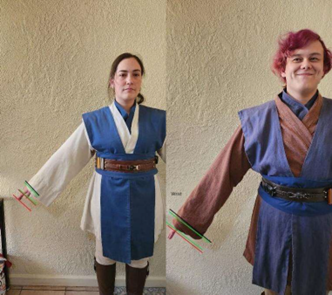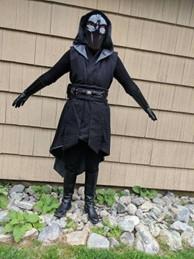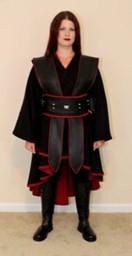Tunics
Outer tunics
Outer tunics may be colors from the primary colors, and may have linings with colors from the secondary colors.
The outer tunic must be long enough to at minimum cover the groin and rear, though it may be longer.
Full length tunics should not drag on the floor and should be hemmed at least a couple of inches off the ground so that they do not present a tripping hazard. Ankle length is a safe choice for choreography.
Tunic should not appear to pull too tight on either side, and should not notably bunch or pucker due to pulling.
The bottom of the “V” where the front of the tunic crosses over should fall notably above the obi. Tunic fit should be adjusted to fit the applicant’s body type.
Tunics may cross either left over right or right over left (though left over right is recommended (wearer’s left and right). However, outer tunic and inner tunic should cross the same way.
There must be no visible vertical seam down the back of the outer tunic.
Pleated sleeves are not permitted for generic Jedi or Sith.
Outer tunics may have slits up the sides or up the back for mobility. However, these slits must not expose the groin or rear, and must not split the tunic skirt into more than 2-3 sections total. These slits should go no higher than the obi.
Outer tunics may have hood if the inner tunic or tabards do not have a hood. The hood of an outer tunic should have the same appearance as a hood on a cloak/robe in shape and construction.
Outer tunics may have; full sleeves, three quarter length sleeves, or be sleeveless.
A vertical seam is allowed in the back.
Full length sleeves must reach past the wrist but not exceed the first knuckle in the hand when arms are held out to the sides at a 45 degree angle and with arms straight (no bend at the elbow). See the picture below for example.
Three- quarter length sleeves and sleeveless outer tunics must be used with either a full-sleeved inner tunic that reaches at least the wrist of the arm, or appropriate arm wraps, armlets, or bracers. These arm wraps/ armlets/ bracers can either be over the cuff of the sleeve so you do not see the end of the sleeve, or under the sleeve so long as the wrap or armlet reaches the wrist of the arm.
Examples of approved costumes, with the allowable sleeve lengths for each costume shown between the green lines.
The location of the wrist is shown with a black line. Sleeve lengths cannot extend past the first red line)
Sleeve seams should be on the underside of the arm, and not visible along the sleeve.
Shoulder seams (for sleeved tunics) or hems (for sleeveless tunics) should rest at the shoulder rather than extending down the bicep. The armscye (ie arm hole) for a sleeved tunic must be fully above the obi. It should extend no further than the mid ribcage, and must be proportional to the wearer.
Sleeveless tunics should have smaller armscyes than sleeved tunics, and cannot show undergarments or excessive skin through the armhole.
Note: many commercially available patterns for tunics have excessively large armscyes which may need to be altered, especially for sleeveless tunics.
Inner Tunics
Inner tunics may be colors from the secondary colors.
They may have one of three styles of collar: Traditional, Mandarin, and Turtleneck/Mock-Turtleneck.
They can either be full sleeved or a dickey that mimics the look.
If done as a dickey, they should give the appearance of being a full under tunic, though visible undersleeves are not necessary unless specific to a character.
Please note that band collars are not permitted.


Band Collars. This style is not approvable for inner tunics
Pleated sleeves are not permitted for generic Jedi, but are permitted for generic Sith.
Inner tunics are permitted to have hoods so long as the tabards and outer tunic do not have a hood. As with hoods on outer tunics, the appearance of the hood should be similar to that of a Jedi robe.
If using a commercially produced shirt as an inner tunic with a sleeveless outer tunic or three-quarter sleeve outer tunic, there should be no visible t-shirt style or knit style cuffs visible. This may be achieved by hand tacking the cuff under in such a way that it is not visible (making sure that the sleeves are still long enough), or by covering the cuff with gloves, bracers, arm wraps, or armlets (please see the Arm and Hand Accessories section for more details on what is approvable).
While knits are permitted for inner tunics which are commercially produced shirts, Under Armor and other athletic training turtlenecks are not allowed due to them being a high sheen fabric.
High-Low Tunics
Both outer and Inner Tunics are permitted to have high-low hems.
Tunics should be tapered in either rounded or angled way and should not simply be the back panel is the longer length.
For tunics that are of a high-low design (e.g. the hem of the back of the tunic is longer than the front) it is acceptable for the rear tabards to run to the rear hem instead of being equal length with the front tabards. It is also acceptable for them to go below the hem in accordance with length rules for tabards.
Please see the tabards section for more specific information.



